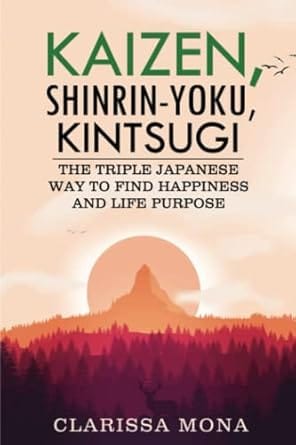After traveling to Japan in 2024, I became a huge fan of Japanese culture and traditions 🇯🇵. From the people to the food to the history 🍱, I found myself loving every aspect and constantly searching for opportunities to learn more 🏯.
Recently as I was browsing online for my next read, Kaizen, Shinrin-Yoku, Kintsugi: The Triple Japanese Way to Find Happiness and Life Purpose by Clarissa Mona immediately caught my eye 👁️. I had heard the concept of Kaizen before but never really dove in to get a better understanding of it 🏊🏻. Long title aside, this book was a perfect blend of learning more about Japanese culture while also find some useful tips for self-improvement 📚.
Here are some of my takeaways:
- Kaizen is a method for making things better. Kaizen is a compound of the Japanese words “kai” meaning “change” and “zen” meaning “good” and roughly translates to ‘continuous improvement’ 📈. Kaizen is about implementing change or improving function through small, incremental movements. This concept can be applied to countless aspects of life, as the book systematically lays out 📖.
- Kaizen prioritizes change the right way. When people look to make a change in their lives, we often want to make that change as quickly and as efficiently as possible 🏃🏾♀️. If someone were to give us a magic wand and an opportunity to skip to the end, many of us would happily take it 🪄. Kaizen, on the other hand, emphasizes consistency, patience, and a constant re-evaluation of oneself and the process 💭. This is not only a healthier and more reasonable way to go about change but also empowers us to learn about ourselves along the way 🛣️.
- Kaizen creates space for self-love and acceptance. Building off that last point, sometimes we can get so focused on the destination that we forget all about the journey 🙈. Say for example you are unhappy with your current job and start hunting for a new one 🔍. You spend hours updating your resume 📄, applying, and interviewing until you finally get hired. Victory 🎉! But almost immediately, you start that new job. Before you know it, you’re buried in work again 😩. Did you ever stop to reflect on what you learned through that process 🤔? Did you ever give yourself credit for your focus or determination? Did you set aside a moment to appreciate that you set a goal, worked, and then achieved it 🏆? By employing Kaizen, we can slow down just enough to create the space for these thoughts, making the process and the result all that more enjoyable 💜.
- Kintsugi can help us appreciate change. Kintsugi is the Japanese art form of repairing broken pottery by filling in the cracks with lacquer that has been mixed with gold or platinum 👑. The result is an entirely new and often more beautiful piece of art 🏺. Mona discusses how Kintsugi is really a metaphor for all change: Instead of becoming depressed or discouraged because of the damage, we should embrace it. A crack, whether it be in a clay pot or our own lives, is not an end but rather a new beginning 😌.
- Getting lost in nature can free the mind. The final Japanese concept discussed in the book, called Shinrin-yoku, also offers a unique perspective. Shinrin-yoku roughly translates as “forest bathing” and refers to the act of being outdoors to promote physical and mental well-being 🌳. This idea is so prominent in Japanese culture that there is an entire medical specialty dedicated to it called Forest Medicine, and patients can be prescribed time to be in nature 🌲. In many large and industrialized cities, it can be hard to escape into nature and savor the fresh air and calming silence it offers 🌬️. Shinrin-yoku is an important reminder to disconnect from the hustle and bustle of daily life occasionally and reap the benefits these simple acts can offer.
Kaizen, Shinrin-yoku, Kintsugi not only made me appreciate Japanese culture and ideologies even more, but introduced me to several new and important concepts. As someone who is always trying to be efficient and literally writes articles on productivity 😅, this was a much needed reminder that change won’t always and can’t always be a rapid process, and there are always lessons to be learned along the way🌄. I think this is beautifully summed up in my favorite quote from the book:
“Today better than yesterday, tomorrow better than today.”
